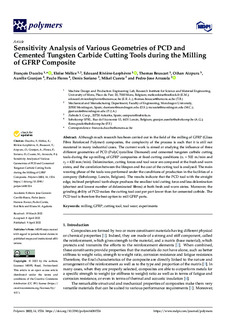| dc.rights.license | Attribution 4.0 International | * |
| dc.contributor.author | Soriano Moreno, Denis | |
| dc.contributor.author | CUESTA ZABALAJAUREGUI, MIKEL | |
| dc.contributor.author | ARRAZOLA, PEDRO JOSE | |
| dc.contributor.other | Ducobu, François | |
| dc.contributor.other | Mélice, Eloïse | |
| dc.contributor.other | Rivière-Lorphèvre, Edouard | |
| dc.contributor.other | Beuscart, Thomas | |
| dc.contributor.other | Aizpuru, Oihan | |
| dc.contributor.other | Granjon, Aurélie | |
| dc.contributor.other | Flores, Paulo | |
| dc.date.accessioned | 2022-05-12T09:22:16Z | |
| dc.date.available | 2022-05-12T09:22:16Z | |
| dc.date.issued | 2022 | |
| dc.identifier.issn | 2073-4360 | en |
| dc.identifier.other | https://katalogoa.mondragon.edu/janium-bin/janium_login_opac.pl?find&ficha_no=167773 | en |
| dc.identifier.uri | https://hdl.handle.net/20.500.11984/5573 | |
| dc.description.abstract | Although much research has been carried out in the field of the milling of GFRP (Glass Fibre Reinforced Polymer) composites, the complexity of the process is such that it is still not mastered in many industrial cases. The current work is aimed at studying the influence of three different geometries of PCD (PolyCrystalline Diamond) and cemented tungsten carbide cutting tools during the up-milling of GFRP composites at fixed cutting conditions (vc = 502 m/min and vf = 420 mm/min). Delamination, cutting forces and tool wear are compared at the fresh and worn states, and the correlation between the lifespan and the cost of the cutting tool is analysed. The main wearing phase of the tools was performed under the conditions of production in the facilities of a company (Sobelcomp, Loncin, Belgium). The results indicate that the PCD tool with the straight edge, inclined peripheral tooth shape produces the smallest total cutting force and less delamination (shortest and lowest number of delaminated fibres) at both fresh and worn states. Moreover, the grinding ability of PCD makes the cutting tool cost per part lower than for cemented carbide. The PCD tool is therefore the best option to mill GFRP parts. | en |
| dc.description.sponsorship | Gobierno Vasco | es |
| dc.language.iso | eng | en |
| dc.publisher | MDPI | en |
| dc.rights | © 2022 by the authors. Licensee MDPI | en |
| dc.rights.uri | http://creativecommons.org/licenses/by/4.0/ | * |
| dc.subject | milling | en |
| dc.subject | GFRP | es |
| dc.subject | cutting tool | en |
| dc.subject | tool wear | en |
| dc.subject | experiments | en |
| dc.title | Sensitivity Analysis of Various Geometries of PCD and Cemented Tungsten Carbide Cutting Tools during the Milling of GFRP Composite | en |
| dcterms.accessRights | http://purl.org/coar/access_right/c_abf2 | en |
| dcterms.source | Polymers | en |
| local.contributor.group | Mecanizado de alto rendimiento | es |
| local.description.peerreviewed | true | en |
| local.identifier.doi | https://doi.org/10.3390/polym14081524 | en |
| local.relation.projectID | info:eu-repo/grantAgreement/GV/Programa de apoyo a la I+D Empresarial Hazitek 2017/ZE-2017-00277/CAPV/Optimización del mecanizado de materiales compuestos y stacks con herramientas de corte especiales/MACHCOMP | en |
| local.contributor.otherinstitution | https://ror.org/02qnnz951 | es |
| local.contributor.otherinstitution | https://ror.org/03jyntf28 | es |
| local.contributor.otherinstitution | Sobelcomp SPRL | es |
| local.source.details | Vol. 14. N. 8. N. artículo 1524, 2022 | en |
| oaire.format.mimetype | application/pdf | |
| oaire.file | $DSPACE\assetstore | |
| oaire.resourceType | http://purl.org/coar/resource_type/c_6501 | en |
| oaire.version | http://purl.org/coar/version/c_970fb48d4fbd8a85 | en |








